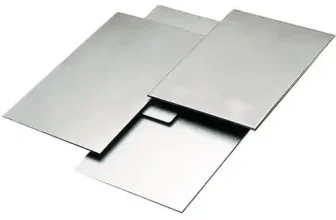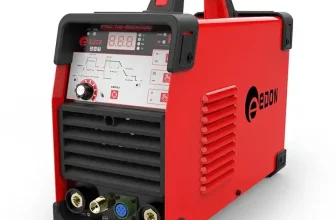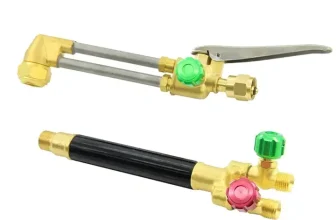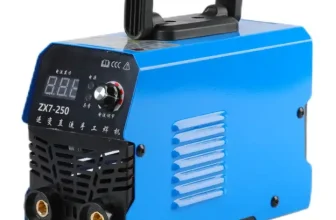Welding is a fabrication process that involves joining two or more
parts together by applying heat, pressure, or both, with or without
filler material. This technique is commonly employed to fuse metals and
thermoplastics, altering the original pieces into a single entity. The
heat source used for welding can arise from an electric arc, a gas
flame, an electron beam, lasers, or friction, among other methods.
From automobiles to bridges, buildings to aircraft, welding is
integral to the structure and function of numerous items around us. Its
application is essential in various sectors like manufacturing,
construction, automotive, aerospace, marine, and many more, making
welding a cornerstone of modern industry. It’s a craft that ranges from
highly mechanized processes in industrial applications to manual tasks
in small-scale workshops or even artistic endeavors.
Importance of
welding in various industry fields
Welding plays a crucial role in multiple industry fields. In the
world of manufacturing, it’s a fundamental process used in making
everything from automobiles to airplanes, trains to ships, and oil
pipelines to wind turbines. Without welding, the construction of these
crucial infrastructures and transportation modes would not be
possible.
Welding is also indispensable in industries such as building
construction and infrastructure development. It provides the robustness
and durability necessary for skyscrapers, bridges, and highways,
enabling these structures to stand strong against numerous environmental
factors.
Moreover, in the energy sector, be it traditional oil and gas or
emerging renewable sources, welding is a key player. It enables the
creation of wind turbine components, the assembly of solar panels, and
the construction of oil and gas pipelines across vast distances.
Additionally, industries heavily reliant on machinery and equipment,
like agriculture and mining, depend on welding for equipment maintenance
and repair. Not to mention the essential role it plays in the crafting
and fixings within the custom automotive field, offering limitless
potential for creativity and unique builds.
From large-scale industrial projects to detailed intricate work,
welding’s importance in various industries is undeniable and
irreplaceable.
What is a Multi Process
Welder
Straightforward
explanation of Multi Process Welder
A Multi Process Welder is a versatile piece of equipment that allows
users to perform multiple welding processes with just one machine. The
main advantage is being able to switch between multiple welding
processes including MIG (Metal Inert Gas), TIG (Tungsten Inert Gas), and
Stick welding. Think of it as a multi-tool for welders, offering the
convenience of adapting to various welding needs without needing to
switch equipment. Ideal for workshops that deal with a range of welding
tasks, it’s designed to be efficient, flexible, and user-friendly,
catering to both beginners and expert welders. It’s a valuable addition
to any toolset, particularly favored for its capacity to handle diverse
welding requirements.
The components of a
Multi Process Welder
A Multi Process Welder is composed of several key components that
allow it to execute multiple varieties of welding. The primary component
is the power source, which can typically be adjusted to accommodate the
power requirements of dissimilar welding processes and materials. This
is often controlled by a user-friendly interface that lets welders
easily switch between processes.
Another significant component is the wire feeder, an essential
element for processes like MIG welding. This device pushes filler metal
wire into the weld pool when operating. Different models may offer
varied speed and tension settings for optimal control.
Multi-process welders also include a torch or welding gun, which
facilitates the creation of an arc and the delivery of filler material.
The type of torch will depend on the welder’s inbuilt functions – these
can range from TIG torches to MIG guns.
Additionally, shielding gas equipment is often part of these types of
welders, as various welding processes require different types of gases
for the most effective performance.
Finally, the welder includes cables, which provide the necessary
electric current to create the arc, and a ground clamp, which secures a
safe return path for this electrical current. These essential components
form a circuit with the welder, the electrode, and the workpiece,
allowing for efficient and effective welding to occur.
How Does a Multi Process
Welder Work?
Description of the working
principle
A multi-process welder uses the principle of joining metals together
by heating the surfaces to their melting point. This heating can be
achieved through various methods including electric arc, gas flames,
lasers, or ultrasonic waves, depending on the type of welding process
being used.
Here’s a general step-by-step breakdown: First, the machine is
powered on, and the user chooses the desired welding process, depending
on the task at hand. The welder then creates intense heat which creates
a molten pool on the metals to be joined.
In the case of Tungsten Inert Gas (TIG) welding, an electric arc
forms between the non-consumable tungsten electrode and the workpiece.
This arc generates heat, melting the metal workpiece. If filler metal is
required, it is manually added into the weld pool. An inert shielding
gas such as Argon is concurrently passed, protecting the tungsten
electrode and the weld pool from oxidation and other atmospheric
contamination.
For Metal Inert Gas (MIG) welding, a wire electrode is continuously
fed into the weld pool while an electric arc forms between the workpiece
and the electrode. Concurrently, a shielding gas is supplied, protecting
the wire, weld pool, arc, and the heat-affected zones from atmospheric
contamination.
Shielded Metal Arc Welding (SMAW) or stick welding involves creating
an electric arc between the stick electrode and the workpiece. The
electrode’s outer coating disintegrates during welding, providing a
shielding gas that protects the weld pool from atmospheric
contamination.
Depending on the selected process, the welder adjusts parameters such
as voltage, current, and wire feed speed to suit the specific
requirements of the welding task. After the metals have been
successfully joined and the weld pool has solidified, the user may opt
to smooth the weld bead using a grinding tool, creating a neat
finish.
In essence, a multi-process welder works by creating a concentrated
heat source to join metals, with the user choosing the most suitable
process for the welding task at hand. The machine then adjusts to
provide the necessary conditions for that process to function
efficiently and effectively.
The different welding
processes involved
A multi process welder is a versatile tool because it integrates
multiple welding processes into a single unit. The primary welding
processes it incorporates include:
- MIG (Metal Inert Gas) Welding: This process uses a continuous
feed of wire that burns, melts and fuses both the base and parent
material together. Shielding gas flows from the welding gun, protecting
the weld pool from contamination. MIG welding is renowned for its speed,
as well as its adaptability to various metal types and
thicknesses. - TIG (Tungsten Inert Gas) Welding: TIG welding is a manual welding
process that requires a lot of skill. It involves using a non-consumable
tungsten electrode, which delivers the current to the welding arc. A
shielding gas protects the weld and electrode from contamination. TIG
welding is used when precise, high-quality welds are required. - Stick (Shielded Metal Arc) Welding: As one of the oldest welding
methods, stick welding uses an electrode stick to create an arc and melt
the stick, thereby creating the weld. It does not require a shielding
gas as the electrode’s outer coating disintegrates when the stick burns,
creating a protective shield around the weld. Stick welding is ideal for
use on rusty, dirty or outdoor materials where wind could impact the
effectiveness of a shielding gas. - Flux-Cored Arc Welding: This process involves using a
continuously fed consumable electrode containing a flux and a constant
voltage. It can be performed with or without a shielding gas. It’s
popular for its high welding speed and portability.
By combining these key welding types into one machine, a multi
process welder offers the ability to tackle almost any welding
challenge. This is just one of the reasons it’s a firm favorite within
the metalworking industry.
Benefits of Using a
Multi Process Welder
Efficiency in
performing multiple tasks
A multi-process welder excels in providing efficiency in performing
multiple tasks. One of the biggest selling points of these machines is
their ability to handle an array of welding processes flawlessly.
Whether it’s Stick, MIG, TIG, or Flux-Cored welding, a multi-process
welder can switch between them with ease, eliminating the need for
multiple individual machines. This attribute alone significantly saves
operation time, enhancing overall productivity.
For professionals working with diverse welding processes daily, this
means a multi-process welder’s ability to switch roles facilitates a
multi-faceted workflow. They no longer have to stop work to change from
one welder to another; a simple adjustment on the multi-process welder
promptly adapts to the requirements of the next task. This seamless
transition not only makes the welder more efficient in terms of time and
effort but also streamlined regarding workspace organization. All of
these factors play a crucial role in improving operational
efficiency.
Cost-effectiveness
Multi-process welders are incredibly cost-effective, offering a high
return on investment for businesses or individual users. Unlike
purchasing separate machines for each welding process, investing in a
single multi-process welder significantly reduces upfront equipment
expenses. It also removes the need for multiple high-cost equipment
purchases, as a single device can handle multiple welding tasks.
Moreover, multi-process welders reduce operational costs over time.
By consolidating the functions of multiple machines into one, the cost
for maintenance, repairs, and replacements becomes much more manageable
from a financial standpoint.
Lastly, by saving on space that would have otherwise been taken up by
several machines, users often find that efficiency improves, leading to
an increase in productivity. More work can be accomplished in a shorter
amount of time, thus improving earnings potential.
In summary, the multi-process welder is an advantageous addition for
those looking to optimize their welding operations, proving to be
cost-effective on multiple fronts – from equipment purchase, maintenance
costs, to operational efficiency.
Versatility on various metal
types
A stand-out advantage of multi-process welders is their versatility
on various metal types. Unlike single-process machines, they can work
effectively on a diverse range of metals, including steel, aluminum,
copper, bronze, and more. This is due to the different welding processes
incorporated in one machine.
For example, TIG welding, one of the processes in a multi-process
welder, can be used on thin sheets of stainless steel and non-ferrous
metals like aluminum, magnesium and copper alloys. The MIG process is
well-suited for steel and aluminum, while the stick welding process is
useful for outdoor welding on iron and steel, even in harsh weather
conditions. Therefore, by having the capability to switch between these
processes, a multi-process welder offers truly transformative
flexibility.
So, no matter what type of project you’re working on, having a device
that can adeptly handle a wide range of metals is a great asset. It
maximizes adaptability, allowing welders to not only switch between
tasks swiftly but also guarantee the quality and durability of the
welds. The versatility of a multi-process welder significantly enhances
its willfulness across industrial and residential applications alike.
For professionals who deal with different metals, these machines offer a
one-size-fits-all solution, making them an indispensable tool in the
welding industry.
Popular Models of Multi
Process Welders
Details of popular models
The market is quite diverse when it comes to multi process welders,
with several models boasting their unique features and capabilities.
Let’s highlight a few popular ones.
First, we have the Miller Electric Multimatic 220 AC/DC. This unit
stands out for its versatility; it delivers MIG, TIG, and Stick welding
capabilities. Notably, it offers AC and DC TIG for versatility in
welding different materials. It is equipped with an easy-to-understand
interface and an automatic setting feature that ensures adjustment is a
breeze.
Next is the Lincoln Electric Power MIG 210 MP. This welder is a
favorite for DIY enthusiasts and professionals alike, thanks to its
simple setup and strong performance. It is portable, compact, and
user-friendly. It offers four processes: MIG, Flux-Cored, DC Stick, and
DC TIG.
Another noteworthy model is the ESAB Rebel EMP 215ic. It is applauded
for its rugged design and technological features. The welder has sMIG
(smart MIG) technology that adapts to user’s welding style, enhancing
user-friendliness. This model offers MIG, Flux-Cored, Stick, and TIG
welding options.
Lastly, the Hobart Handler 210 MVP stands out for its dual-voltage
capability, allowing it to run on either 120V or 240V input power. It
provides both MIG and flux-cored welding options. This unit is known for
its durability and excellent performance.
Each of these models has its unique strengths, catering to the
different needs of welders. Whether it’s the kind of welding process,
material variety, user-friendliness, or power specifications, there’s a
welder to suit every requirement.
Pros and cons of each model
The first model that comes to mind when discussing popular
multi-process welders is the Lincoln Electric Power MIG 210 MP. Praised
for its lightweight and portable design, this model is perfect for
on-the-go jobs or quick fixes. It offers multiple processes including
MIG, Stick, TIG, and Flux-cored. However, it does have some drawbacks,
the major one being that it requires an additional purchase for a spool
gun, which can be a significant cost.
Then we have the ESAB Rebel EMP 205ic, another highly-regarded player
in the industry. Known for its True Multi-Process capabilities including
MIG, Flux-Cored, Stick, and TIG, it truly lives up to its reputation.
Its advanced digital controls are commendable but can be tricky for
beginners to navigate. Furthermore, its higher price point may not be
affordable for hobbyists or those on a stringent budget.
Another top contender is the Forney Easy Weld 140 MP. This model is
well-reputed for being newbie-friendly with its simple setup and
operation. It excels in MIG and Stick welding but only offers basic TIG
capabilities, which can be a limiting factor for professionals seeking
advanced performance. The Forney Easy Weld 140 MP has a lower price
point, making it accessible for entry-level welders. However, its
compatibility with only smaller wire spools limits its usability for
larger projects.
Lastly, the Miller Electric Multimatic 220 is seen as a premium
multi-process welder, offering superior performance across all processes
– MIG, Flux-cored, Stick, and meticulous AC/DC TIG. While its versatile
functionalities are impressive, the high price can potentially dissuade
occasional users and hobbyists.
Each of these models has its own strengths and shortcomings. The best
pick depends on factors such as usage, requirements, proficiency level,
and budget considerations.
Safety
Measures When Using a Multi Process Welder
Necessary
protective gear for using a Multi Process Welder
Safety when using a Multi Process Welder is of utmost importance as
it ensures the well-being of the operator and those around them. The
machine, if not handled with proper gear, can cause serious harm,
including burns and eye injuries.
One of the fundamental pieces of protective gear necessary for
operating the welder is a helmet. The welding helmet not only protects
our head and hair from sparks but also our eyes from the intense light
produced during the process. It is vital to use a helmet with an
auto-darkening feature as it matches the level of light, ensuring both
safety and productivity.
Another important piece of gear is a suitable pair of gloves. Welding
gloves are typically made of durable leather and are designed to protect
our hands from heat, sparks, and sharp objects while also allowing us to
maintain a good grip on the machine.
Welding jackets, aprons, or coveralls are also necessary, offering
protection against heat, sparks, and sharp objects. These items are
typically flame resistant and designed to cover most parts of the body
vulnerable to flying sparks and hot slag.
Lastly, safety glasses, worn under the helmet, give an added layer of
protection to our eyes from flying debris. Also, using good quality work
boots can shield our feet from falling sparks and hot pieces of metal.
Remember that footwear for welding should be slip-resistant and ideally
made of leather.
The key to safety boils down to this – wear the right gear, pay
attention, and respect the machine. This way, you can get your welding
jobs done efficiently, safely, and productively.
Safety practices
while operating the machine
To ensure your safety, it’s paramount to adhere to certain practices
while operating a multi-process welder. Power off the machine before
initiating any repairs or modifications, to prevent electric shocks or
accidental operation. Carefully arrange and manage all connecting cables
to avoid tripping or snagging hazards.
Keep the welder’s work area decluttered and clean to minimize risk of
accidental fires. Sparks and hot metal fragments generated from welding
can easily ignite flammable materials. Remove all flammables from your
vicinity before operating the welder.
Proper ventilation is essential. Harmful fumes or gases can be
produced during welding, particularly if you’re working with certain
types of metals. Consider using fume extraction equipment or perform the
operation in a well-ventilated space to prevent inhalation of dangerous
substances.
Finally, avoid touching live electrical parts and always wear
insulated gloves and protective eye wear. Following these safety
practices can effectively reduce the risk of accidents or injuries,
enabling a safe and productive welding operation.
Conclusion
Recap
of the benefits and functions of a Multi Process Welder
A Multi Process Welder is an advantageous tool in various industrial
fields due to its cost-effectiveness, efficiency, and versatility. Its
capacity to perform multiple types of welding tasks makes it a go-to
piece of equipment for professionals. Whether it’s stick welding for
outdoor projects, TIG welding for precision work, or MIG welding for
speed, this machine can adapt to a wide array of applications. Remember,
using a Multi Process Welder not only simplifies the task at hand but
also eliminates the cost of purchasing, maintaining, and storing
separate machines for each welding process. However, despite the ease it
affords, safety should never be compromised. Using the right protective
gear and adhering to safety practices while operating a Multi Process
Welder are paramount. In brief, the Multi Process Welder embodies
versatility, efficiency, and cost-effectiveness, making it a valuable
tool in the construction and manufacturing world.
Importance of safety
measures
Ensuring safety while working with a Multi Process Welder is
absolutely paramount. The use of protective gear such as welding
helmets, gloves, and suitable clothing can significantly reduce the
risks of burns and injuries. Furthermore, adhering to safety practices
like correct equipment setup, avoiding flammable materials, and taking
regular breaks is critical to maintain a safe working environment. In
essence, while the Multi Process Welder provides many benefits and
efficiencies, they should never be at the cost of one’s safety. Always
prioritize safety precautions to ensure a productive and hazard-free
welding experience.







